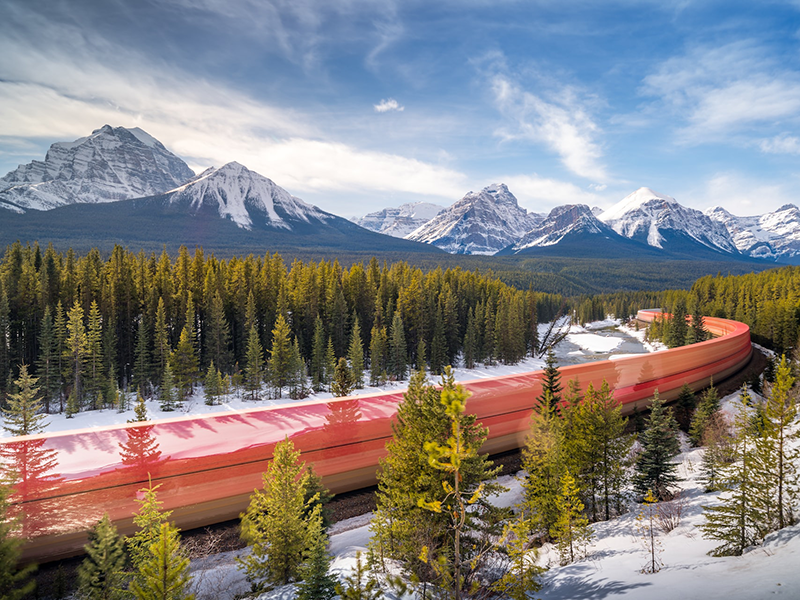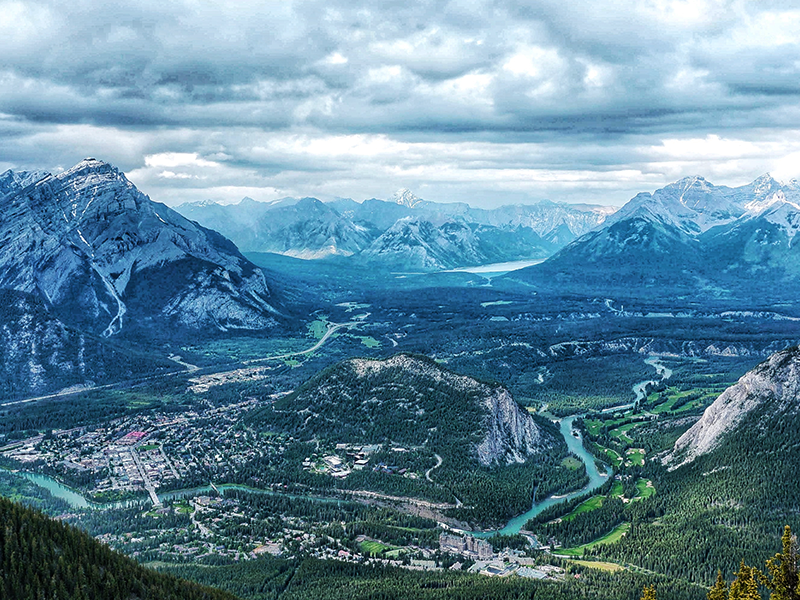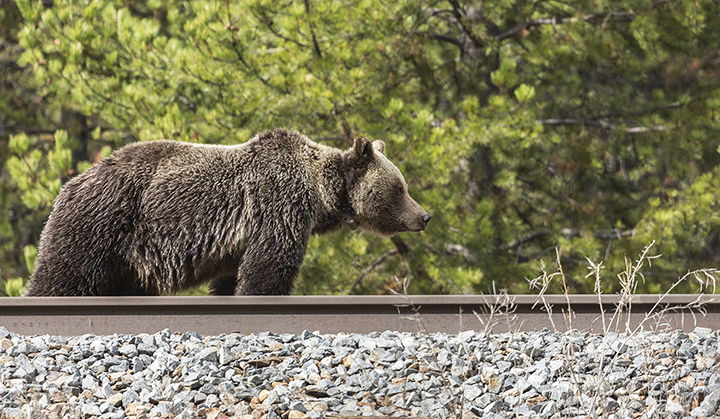Communities, conservation and wildlife must be centered in the conversation on new developments in the Bow Valley
Wildlife and people in the Yellowstone to Yukon region are always on the move.
Transportation that accounts for the well-being of wildlife, the planet and people is increasingly important as we navigate a changing climate and habitat loss. However, this is not the case with the latest proposal for a new passenger rail line from the Calgary Airport to the Town of Banff.
A coalition of conservation and environmental organizations, including Yellowstone to Yukon Conservation Initiative (Y2Y), Canadian Parks and Wilderness Society, Bow Valley Naturalists, Alberta Wilderness Association, and Bow Valley Climate Action, are ringing the alarm bells to ensure this proposal gets it right for nature and people’s benefit in the long-term.
WHAT’S BEING PROPOSED?
Privately-owned Liricon Capital Inc. is the lead backer of this proposal. The public vision for the project is to increase tourism to Calgary and Banff by providing another means of transportation to tourists.
A new passenger rail line between Calgary and Banff was first proposed in 2019. This proposal was updated in 2022 and the proponent approached the Alberta government to seek help with funding.
Recently, the Alberta government announced it would not provide funding towards the $30 million annual operating subsidy for this project. Despite this setback for the project, another iteration of the proposal should be expected.

WHY IS THIS A CONCERN?
This new rail line would cut through the Bow Valley, one of the most important east-west wildlife corridors in the Yellowstone to Yukon region.
This is a region that wildlife relies on to access important habitats. It’s also a place where people from all over the world visit for awe-inspiring landscapes, animals, and nature-based experiences.
And yet, despite these many values of the land the Calgary-Banff rail would bisect, the current project proposal fails to outline how it would support communities, conservation and wildlife connectivity.
Y2Y supports nature-positive economies and is advancing this work regionally. However, in the context of biodiversity loss, climate change, and the need to address and respect First Nations Treaty Rights and advance Truth and Reconciliation, a strong economy over the long term is only possible if nature and people can thrive together.
In a joint statement, coalition members, have voiced collective concerns about the proposal.
Y2Y does not oppose development, and supports transit options that result in fewer individual vehicles on the road. However, the current Calgary-Banff rail proposal falls short of what is needed to help people and nature thrive.
WHAT’S MISSING FROM THE PROPOSAL?
A transportation solution that meets the needs of the Bow Valley’s communities — and its natural spaces — must include:
- Strategies to keep wildlife habitat connected — to prevent further damage to landscapes and to decrease wildlife deaths on roads and rail
- Connection to a larger regional tourism planning strategy that mitigates cumulative effects from development and tourism
- Commitment to green hydrogen power to mitigate greenhouse gas emissions
- Solutions to regional affordability and workforce challenges
Wildlife connectivity, climate change, and the impact of increased human activity in the Bow Valley needs to be brought to the center of the conversation to get the Banff-Calgary rail line proposal on track for supporting nature and communities.
Ways to keep wildlife connected
Wildlife living in and moving through the Bow Valley are already challenged by an existing rail line, roads, development, and human activity. Between 2005 and 2017, Parks Canada recorded more than 400 incidents of wildlife deaths by rail strikes in Banff National Park. Now, the Calgary-Banff rail line proposes to double the intensity of use of the existing rail corridor.
The 2022 Parks Canada Management Plan cited that, despite efforts to reduce wildlife deaths from train strikes and vehicles in Banff National Park, there’s much more work to be done — and the proposed rail line project would “augment these challenges.”
Wildlife connectivity, and increase in the effects on wildlife from more people visiting the Bow Valley, must be priorities in this new rail line proposal. This should include more wildlife crossings, fencing, and reduced speed zones for all trains, to reduce the number of wildlife being struck and killed.
Consideration of cumulative effects
This rail project aims to bring more tourism to the Kananaskis-Canmore-Banff region. It should outline ways to keep the important ecosystems in these areas intact. This will also support Parks Canada’s top mandate of maintaining “ecological integrity” throughout the region.
‘Cumulative effects’ refers to the combined past, present and foreseeable future impacts of human activity in an area. A key concern with this proposal is how it will contribute to these snowballing impacts upon the Bow Valley and its wildlife.
In spring 2022, new modeling from Y2Y and ALCES Land-Use looked at past, present and future human impacts on grizzly bear movement. This research shows how grizzly bear movement paths have already been dramatically altered; but, carefully-planned development and well-managed recreation can help prevent further loss of habitat and reduce the risk of human-wildlife conflict.
A project at the scale of the Calgary-Banff rail line address how to keep wildlife habitat connected and protected; as well, it must help address impacts from increased tourism by contributing to local and regional regenerative tourism efforts.

Commitments to address climate change
With a changing climate also comes the need for animals to adapt. We must give wildlife the space and opportunities to find food and habitat they need to thrive. Major decisions such as this must be a solution to address climate change, not a step backward. That includes this rail project as it is proposed.
A rail project like this should be part of solutions to address climate change.
However, even with the declaration of climate emergencies in the municipalities of Calgary, Banff, and Canmore, this proposal does not fully commit to green hydrogen power, which would lessen the train’s contribution to greenhouse gas emissions.
Just as important as transportation alternatives is the plan to achieve a shift in how people travel. There isn’t a clear equitable strategy for getting people out of their cars and on to the train. Rather, it’s likely to add to the number of people traveling.
Housing affordability and workforce challenges
People benefit when nature is healthy.
A rail project such as this has a responsibility to the communities it plans to serve. For example, it can help address the housing affordability and workforce challenges felt throughout the Bow Valley region.
If this project makes commuting by rail more affordable than living within towns like Canmore and Banff, these Bow Valley communities could be negatively impacted.
The top characteristic of resilient communities is diversity. To help ensure a diversity of people and businesses still exist in the Bow Valley, this project should support affordable housing solutions and nature-positive economic development initiatives in the towns through which the train would travel.
HOW YOU CAN HELP
A new iteration of this proposal should address these considerations. We must also continue to speak up for the wildlife, people and landscapes of the Bow Valley and share our collective concerns with decision-makers.
At this stage, there are a few ways you can get on board to help:
- Spread the word — Share with others how this current proposal does not fully consider the well-being of wildlife, the planet and people.
- Have your voice heard — If you live, play, or work along the proposed rail corridor, make sure your community has a seat at the table and its needs are being considered and included in the solution.
- Contact government decision-makers — If necessary, remind them that national parks and adjacent public lands are for all Canadians to enjoy. Any decisions related to their use should involve public input.
- Stay informed — Sign up for Y2Y’s action alerts and stay updated with future opportunities to get engaged.
The Bow Valley provides unparalleled experiences in nature for those who live in and visit it. It is also one of the most important places for wildlife in the Yellowstone to Yukon region.
Moving forward, wildlife connectivity, climate change, and the impact of increased human activity in the Bow Valley needs to be brought to the center of the conversation to get the Banff-Calgary rail line proposal on track for supporting nature and communities.
ADDITIONAL READING
- The Banff-Bow Valley Study from 1996 concluded that the region was on a path that would erode the very values for which it was known and loved by residents and visitors alike.
- Towns and trails drive carnivore movement behaviour, resource selection, and connectivity (Whittington et al. 2022) – This paper analyzed 20 years of wolf and grizzly bear movement data and concluded that the Bow Valley has already lost up to 85 per cent of its best wildlife habitat.
- Grizzly Bear Movement and Conflict Risk in the Bow Valley: A Cumulative Effects Model (Y2Y and ALCES Group 2022) – This research looked at past, present and future human impacts on grizzly bears and clearly demonstrates how grizzly bear movement paths have already been dramatically altered, along with the need for carefully-planned development and well-managed recreation to mitigate further habitat reduction and the risk of human-wildlife conflict.


